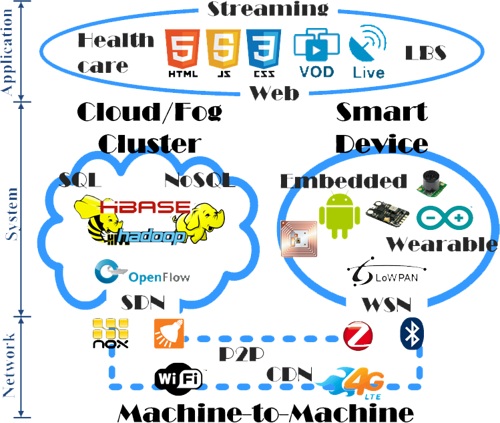NESL Research Roadmap (實驗室發展路徑) v2020
<Research Interests>
- IoT Eco-systems
- Healthcare Wearable/Embedded Devices
- P2P/Web Multimedia Streaming Services
- Vehicular/Sensor/Software-defined Networks
- Intelligent Cloud Databases
In order to develop an Internet of Things (IoT) ecosystem, Networked & Embedded Systems Laboratory (NESL) led by Dr. Chao-Hsien Lee divides the research scope into three levels, i.e. (a) application, (b) system, and (c) network. In the system level, it is further divided into (i) backhaul, i.e., cloud, fog, and edge, and (ii) end terminals, including smart, embedded and wearable devices.
1. Smart devices, including Android and Windows Phones, play the core role of user interaction and integrate with the embedded sensors or wearable accessories based on Arduino for environment detection.
2. Cloud/Fog/Edge clusters based on Hadoop provide highly-efficient computing power and storage for big data, such as HDFS and SQL/NoSQL databases. Then, artifical intelligent (AI)/machine learning (ML) algorithms can be used to data analysis and decision support.
3. Heterogeneous Internet of Things (IoT)) technologies are responsible for (i) data collection from sensors by means of a wireless sensor network (WSN), (ii) information exchange between backhaul and end terminals using peer to peer (P2P) and content delivery network (CDN), or (iii) interconnection inside the cloud cluster, e.g., software defined network (SDN) and then achieve autonomous machine-to-machine (M2M) communication.
4. Various brandnew network applications and services are developed and optimized in the aforementioned infrastructure. In addition to traditional web-based multimedia live streaming services, location-based services (LBS) exploiting user geographical locations, healthcare services according user behavior or vital signs, and industrial ultra-reliable and low-latency communications (URLLC) are also considered as the next-generation killer applications of IoT.

<研究方向>
- 物聯網生態系統
- 健康照護穿戴式裝置
- P2P/Web多媒體服務
- 車用/感測/軟體定義網路
- 智慧雲端資料庫
由李昭賢博士指導之網路暨嵌入式系統實驗室總體目標:為建構一個物聯網(Internet of Things,IoT)生態系統(Ecosystem),分成(i)網路(Network)、(ii)系統(System)與(iii)應用(Application)三方面。
1. 在Android/Windows Phone智慧型裝置(Smart Device)負責使用者互動,並使用Arduino軟硬體電子開發平台整合嵌入式感測器(Embedded Sensors)或穿戴式週邊(Wearable Accessories)以感測周圍環境變化;
2. 在雲端(Cloud)/霧端(Fog)/邊緣(Edge)提供高效率計算能力,以及可儲存巨量資料(Big Data)的儲存空間,可進一步運行機器學習(Machine Learning)演算法達成資料分析(Data Analysis)與決策支援(Decision Support);
3. 導入物聯網(Internet of Things,IoT)技術建構(i)異質化(Heterogeneous)的機器聯網(Machine-to-Machine,M2M)、(ii)前、後端資料傳輸的同儕(Peer to Peer,P2P)網路與內容派送網路(Content Delivery Network,CDN)、(iii)叢集內部之軟體定義網路(Software Defined Network,SDN);
4. 立基於上述基礎架構,研發各式各樣之嶄新網路應用服務,如:(i)建構於網頁(Web)之多媒體即時串流(Multimedia Live Streaming)服務、(ii)以使用者地理位置之位置導向服務(Location-based Service,LBS)、(iii)以使用者行為(User Behavior)或生理訊號(Vital Signs)之健康照護(Healthcare)服務、與(iv)工業製造所需超可靠、低延遲通訊服務。
